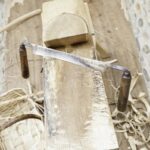Woodworkers rely on a variety of tools to create their masterpieces, and one essential tool is the woodworker’s mallet. This humble yet indispensable tool plays a crucial role in shaping and joining wood pieces together.
But when it comes to making a woodworker’s mallet, one of the most important decisions is choosing the right type of wood. In this article, we will explore the best wood options for a woodworker’s mallet and understand why this decision holds such significance.
Wood selection for a woodworker’s mallet goes beyond just aesthetics; it directly affects its performance and durability. The ideal wood should possess certain qualities that make it suitable for withstanding repeated impact, have the right weight that provides control and balance, and offer longevity to withstand years of heavy use. Balancing these factors can be challenging, but finding the perfect wood for your mallet can greatly enhance your woodworking experience.
In this comprehensive guide, we will delve into different types of woods commonly used for crafting a woodworker’s mallet. We will explore hardwoods like oak, hickory, and maple known for their durability and strength. Additionally, we will look at exotic woods such as ebony, purpleheart, and cocobolo which offer unique characteristics prized by many craftsmen.
Furthermore, we will also consider softwoods like pine, spruce, and cedar known for their lightweight nature. By understanding the qualities of each type of wood and considering professional opinions within the woodworking community, you can make an informed decision when selecting the best wood for your own woodworker’s mallet.
So whether you are an experienced craftsperson or just starting your journey in woodworking, read on to discover the importance of choosing the right wood for a woodworker’s mallet and gain invaluable insights into selecting the perfect material that suits your individual needs.
Understanding the role of a woodworker’s mallet
A woodworker’s mallet is an essential tool in a woodworker’s arsenal. It serves multiple purposes and plays a crucial role in various woodworking tasks. Understanding the importance and function of a woodworker’s mallet is essential to choose the right wood for its construction.
Firstly, a woodworker’s mallet is used for striking chisels and gouges during carving or shaping wood. The weight of the mallet provides the necessary force required to drive these tools into the material. Additionally, it helps prevent damaging or denting the handle of other tools, as the soft wooden head absorbs the impact.
Secondly, a woodworker’s mallet can be used for assembly and joinery work. It aids in fitting snug joints together by gently tapping them into place without causing damage to delicate parts or misalignments. The controlled strikes delivered by a mallet ensure precision and accuracy in woodworking projects.
Lastly, a woodworker’s mallet can also be used for general purpose hammering tasks such as driving nails or removing stubborn dowels. Its versatile nature makes it an indispensable tool that can be utilized in various woodworking applications.
To fulfill these roles effectively, certain factors need to be considered when selecting the appropriate wood for a woodworker’s mallet. Density, durability, and weight are key characteristics that should be evaluated.
- Density: Choosing a dense wood ensures that the mallet can deliver sufficient force without deforming or splitting under pressure. Dense woods provide excellent shock absorption capabilities while maintaining their structural integrity over time.
- Durability: Since a woodworker’s mallet is subjected to frequent heavy blows, durability is crucial. Opting for a hardwood with high durability ensures that your mallet will withstand prolonged use without showing signs of wear and tear.
- Weight: The weight of your mallet plays a role in determining how easily it can drive chisels and carve through materials. While lighter woods may reduce user fatigue during prolonged use, heavier woods often provide better force transmission due to their mass.
By considering these factors and understanding the roles a woodworker’s mallet plays, you can make an informed decision when selecting the best wood for your mallet.
Factors to consider when selecting wood for a woodworker’s mallet
When it comes to selecting the best wood for a woodworker’s mallet, there are several factors that need to be considered. These factors include density, durability, and weight of the wood. Each of these characteristics plays a crucial role in determining the effectiveness and longevity of the mallet.
Density
The density of the wood is an important factor to consider when choosing a woodworker’s mallet. Generally, denser woods tend to have better impact resistance and provide more force with each strike. This is because dense woods absorb less vibration and transfer more energy to the workpiece. Some popular options for dense woods include oak, hickory, and maple.
Durability
Durability is another essential factor when selecting wood for a woodworker’s mallet. A durable wood will withstand constant use and prevent premature wear and tear. It should be able to withstand heavy pounding without splintering or breaking easily. Hardwoods like oak, hickory, and maple are known for their durability and can withstand the demands of woodworking tasks.
Weight
The weight of the wood affects the overall balance and feel of the mallet. It is crucial to choose a wood that provides sufficient weight for effective striking power without being too heavy or cumbersome. The weight should allow for precise control over each strike, minimizing fatigue during long woodworking sessions. Different woods have varying densities, which directly affect their weight. For example, hickory tends to be heavier than oak or maple.
Considering these factors is vital in ensuring that you choose the right wood for your specific needs as a woodworker. While density contributes to impact resistance and force generation, durability ensures longevity, while weight determines balance and control during use. By carefully considering these factors together with your personal preferences, you can select a suitable wood that will enhance your woodworking experience and provide reliable performance in your woodworking projects.
Exploring the advantages of hardwoods for a woodworker’s mallet
Hardwoods are popular choices among woodworkers for making their mallets due to their strength, durability, and density. Oak, hickory, and maple are three common hardwood options that offer several advantages when used in crafting a woodworker’s mallet.
One advantage of using hardwoods like oak, hickory, and maple is their high density. The density of a wood affects the impact force that can be delivered by the mallet. Hardwoods have a higher density compared to softwoods, which means they can deliver a more powerful blow without damaging the wood being struck. This makes them ideal for tasks such as chiseling or driving joints together.
In addition to their density, hardwoods also offer excellent durability. Oak, hickory, and maple all have good resistance to wear and tear, ensuring that the mallet will stand up to repeated use over time. Durability is an important factor to consider when selecting wood for a woodworker’s mallet because it ensures that the tool will last longer and require less frequent replacement.
Furthermore, hardwoods like oak and hickory are known for their strength and shock-absorbing properties. This means that they can withstand heavy blows without splintering or breaking. Maple is another popular choice as it is tough and has a straight grain structure that helps distribute force evenly throughout the mallet head. These qualities make oak, hickory, and maple well-suited for tasks requiring substantial force or impact.
| Advantages | Oak | Hickory | Maple |
|---|---|---|---|
| Density | High | High | High |
| Durability | Good | Good | Good |
| Strength | High | High | Moderate to high |
| Shock Absorption | Moderate to high | Moderate to high | Moderate to high |
Highlighting the benefits of exotic woods for a woodworker’s mallet
Exotic woods, such as ebony, purpleheart, and cocobolo, offer unique benefits and characteristics that make them excellent choices for a woodworker’s mallet. These woods are prized for their rich colors, exceptional durability, and impressive hardness. In this section, we will explore the advantages of using these exotic woods for crafting a woodworker’s mallet.
Ebony is known for its deep black color and dense nature. It is considered one of the hardest woods available, making it highly resistant to wear and tear. Ebony is also revered for its natural oils that help keep the wood in great condition over time. These properties make ebony an outstanding choice for a woodworker’s mallet as it offers superb durability and strength.
Purpleheart is another exotic wood that stands out for its stunning purple hue. Besides its striking appearance, purpleheart boasts exceptional density and resistance to impact and abrasion. This wood has a high hardness rating, making it an excellent choice when precision and control are essential in woodworking tasks. Additionally, purpleheart is known to have good shock-absorbing properties which can be beneficial during prolonged use.
Cocobolo is a tropical hardwood that showcases warm reddish-brown tones with beautiful grain patterns. It is well-regarded among woodworkers due to its inherent stability and remarkable density. Cocobolo provides both excellent strength and durability which makes it suitable for heavy-duty applications like shaping or carving hard materials. Moreover, this exotic wood has natural oils that contribute to its water resistance, ensuring longevity even in humid environments.
These exotic woods bring distinctive qualities to a woodworker’s mallet, making them ideal choices for those seeking high-performance tools with aesthetic appeal. However, it’s important to note that working with exotic woods can present challenges due to their hardness and density. Woodworkers may need specialized tools or techniques to shape these materials effectively.
| Exotic Wood | Key Characteristics |
|---|---|
| Ebony | Deep black color, exceptional hardness and durability, natural oils for preservation |
| Purpleheart | Rich purple hue, high density and hardness, good shock-absorbing properties |
| Cocobolo | Warm reddish-brown tones with unique grain patterns, remarkable density and stability |
Woodworkers who prefer utilizing exotic woods in their craft can find a wide range of benefits by selecting ebony, purpleheart, or cocobolo for their woodworker’s mallet. These woods not only deliver exceptional performance but also add visual appeal to the tool.
However, it is important to keep in mind the specific characteristics of each wood when working with them and adjust techniques accordingly. By considering personal preferences and woodworking needs, woodworkers can make an informed decision on which exotic wood will best suit their requirements.
Exploring the characteristics of softwoods for a woodworker’s mallet
Softwoods are another option to consider when selecting the best wood for a woodworker’s mallet. While they may not be as commonly used as hardwoods, softwoods have their own unique characteristics that can make them suitable for certain woodworking tasks.
Pine
Pine is a popular choice for beginner woodworkers due to its affordability and availability. It has a moderate density, which provides a good balance of weight and impact resistance. Pine also offers good shock absorption, making it ideal for delicate woodworking projects or when working with softer materials.
However, one drawback of pine is its relative softness compared to hardwoods. This means that pine may be more prone to denting or wear over time, especially if used for heavy-duty applications. Nonetheless, many woodworkers find that the affordability and ease of working with pine outweigh this potential downside.
Spruce
Spruce is another softwood option that can be suitable for a woodworker’s mallet. It is known for its strength-to-weight ratio, as well as its excellent shock-absorbing properties. These characteristics make spruce an excellent choice when precision and finesse are required in woodworking tasks.
One advantage of spruce is its availability in large sizes, allowing woodworkers to create larger mallet heads if needed. Additionally, spruce has minimal grain distortion, which can result in a smoother striking surface on the mallet head.
Cedar
Cedar is a softwood that offers similar qualities to both pine and spruce. It has a moderate density and is lightweight, making it comfortable to use over extended periods without causing fatigue. Cedar also possesses natural oils that contribute to its durability and resistance against rot and decay.
Furthermore, cedar has excellent shock-absorbing capabilities and allows for precise control during striking motions. This makes it an attractive option for woodworking tasks that require finesse or delicate applications.
In summary, while softwoods may not be the first choice for a woodworker’s mallet, they can still be suitable depending on the specific needs of the user. Pine is a commonly used softwood due to its affordability and moderate density. Spruce offers excellent strength-to-weight ratio and shock-absorbing properties, making it ideal for precision tasks.
Cedar, on the other hand, combines moderate density with natural durability and rot resistance. Ultimately, the choice of wood for a woodworker’s mallet depends on personal preference, woodworking requirements, and budget constraints.
Considering alternative options
Alternative options to traditional wooden mallets include metal-headed mallets and mallets with replaceable heads. These options offer distinct advantages and may be worth considering for certain woodworking tasks.
Metal-headed mallets, often made from brass or steel, provide a different feel and impact compared to wooden mallets. They are known for their durability and ability to deliver powerful blows. The weight of the metal head also adds momentum to each strike, allowing for more efficient and effective chiseling or carving. Metal-headed mallets are particularly useful when working with harder materials or when precise control over the force of impact is required.
Mallets with replaceable heads are designed with convenience in mind. These mallets typically feature a handle that can accommodate various interchangeable heads made from different materials. This versatility allows woodworkers to switch between heads based on the specific task at hand.
For instance, a softer head may be preferred for delicate or intricate work, while a harder head may be used for heavier-duty tasks. Mallets with replaceable heads offer flexibility and can save both time and money by eliminating the need for multiple specialized mallets.
Professional woodworkers’ opinions on the best wood for a woodworker’s mallet
Professional woodworkers have varying opinions when it comes to choosing the best wood for a woodworker’s mallet. Some prefer hardwoods like oak, hickory, and maple, while others prefer the unique qualities offered by exotic woods such as ebony, purpleheart, and cocobolo.
Additionally, there are woodworkers who find softwoods like pine, spruce, and cedar to be suitable for their mallets. Each type of wood offers different advantages and disadvantages depending on personal preference and the requirements of the specific woodworking project.
Many professional woodworkers lean towards hardwoods when it comes to selecting the best wood for a woodworker’s mallet. Hardwoods are known for their density and durability, making them ideal for withstanding frequent heavy blows without denting or splintering. Oak is a popular choice because it is strong and resistant to wear and tear.
Hickory is another common option due to its excellent shock-absorbing properties that reduce strain on the user’s hand during use. Maple is also favored for its sturdiness and resistance to chipping.
On the other hand, some professional woodworkers prefer working with exotic woods in order to take advantage of their unique qualities. Ebony is a dense and heavy hardwood that provides exceptional strength and durability. Purpleheart offers excellent impact resistance with its vibrant purple color adding aesthetic appeal. Cocobolo is known for its beautiful grain patterns and high oil content which acts as a natural barrier against moisture, making it highly resistant to water damage.
While softwoods may not be as popular among professional woodworkers for mallet construction, they do have their own set of advantages. Softwoods like pine, spruce, and cedar offer lighter weight options compared to hardwoods which can be beneficial for those who prefer a lighter mallet. Softwoods can absorb shock well due to their inherent resilience but may not offer the same level of durability in comparison to hardwoods or exotic woods.
Ultimately, the choice of wood for a woodworker’s mallet is dependent on personal preference and specific requirements. It is recommended to try out different woods through trial and error to determine which wood best suits individual needs. Consulting with experienced professionals and seeking their opinions can also provide valuable insights before making a final decision on the best wood for a woodworker’s mallet.
Expert tips and recommendations for choosing the best wood for a woodworker’s mallet
Choosing the right wood for a woodworker’s mallet is crucial for achieving optimal performance and longevity. Here are some expert tips and recommendations to help you select the best wood for your mallet:
- Consider the density: The density of the wood is essential in determining the striking force and durability of the mallet. Generally, denser woods are preferred as they provide better impact and have a longer lifespan. Hardwoods such as oak, hickory, and maple are known for their high density and make excellent choices for a woodworker’s mallet.
- Evaluate durability: Durability is another important factor to consider when choosing wood for a mallet. You want a material that will withstand repeated striking without splintering or cracking. Oak is highly regarded among woodworkers for its exceptional durability, making it an excellent choice for a mallet that can endure heavy use.
- Consider weight: The weight of the mallet plays a significant role in control and comfort during woodworking tasks. Lighter woods may provide better precision, while heavier woods may offer more striking force. It ultimately depends on personal preference and the specific tasks you’ll be performing. Maple is often favored by woodworkers due to its balance of weight and hardness, making it suitable for various applications.
- Seek guidance from experienced woodworkers: Professional woodworkers have valuable insights based on their experience with different types of woods for mallets. They can offer specific recommendations based on your needs and preferences.
- Test different materials: Don’t hesitate to experiment with different woods before settling on one option. Try making smaller test mallets from various woods to assess their performance, feel, and suitability for your woodworking projects.
Remember that choosing the best wood for a woodworker’s mallet ultimately depends on personal preference, project requirements, and desired performance characteristics. By considering factors such as density, durability, and weight, seeking advice from experienced woodworkers, and testing various materials, you can find the perfect wood that enhances your woodworking experience and provides years of reliable service.
Conclusion
Choosing the right wood for a woodworker’s mallet is crucial in enhancing your woodworking experience. Throughout this article, we have explored various factors to consider when selecting wood for a mallet, including density, durability, and weight. We have also delved into different types of woods, such as hardwoods, exotic woods, and softwoods, each with their own unique characteristics and benefits.
Hardwoods like oak, hickory, and maple are popular choices due to their strength and abrasion resistance. They provide the necessary heft and stability required for effective striking without compromising on durability. On the other hand, exotic woods such as ebony, purpleheart, and cocobolo offer distinct aesthetics while maintaining excellent strength properties. These woods can add beauty to your woodworking projects while still providing a reliable tool.
We have also touched upon softwoods like pine, spruce, and cedar which may not possess the same hardness as hardwoods but can still be suitable for certain applications. Softwoods are lighter in weight and offer a gentler impact on delicate materials or intricate joinery work.
While the choice of wood ultimately depends on personal preference and specific needs of each woodworker, it is worth considering alternative options such as metal-headed mallets or mallets with replaceable heads. These options provide versatility and convenience depending on the nature of your projects.
In conclusion, finding the perfect wood for your woodworker’s mallet is essential in optimizing your woodworking experience. Understanding the role of a mallet and considering factors like density, durability, and weight will help guide you in making an informed decision. Whether you prefer hardwoods for their strength or exotic woods for their aesthetic appeal or even softwoods for their lightweight nature – there is a suitable option out there for you.
Experimenting with different types of woods will allow you to discover what works best for your particular needs as a woodworker. Choose wisely and let your mallet enhance your woodworking journey.
Frequently Asked Questions
What type of wood are mallets made from?
Mallets are typically made from different types of wood depending on their purpose and desired characteristics. One common type of wood used for mallets is beechwood. Beechwood is known for its durability, strength, and resistance to shock.
It also has a smooth texture and straight grain, making it easier to shape into the desired mallet design. Other types of wood used for mallets include maple, oak, and hickory, each with its own unique properties that may suit specific woodworking tasks or personal preferences.
What is the best weight for a woodworking mallet?
The ideal weight for a woodworking mallet can vary depending on the user’s personal preference and the specific woodworking task at hand. In general, a woodworking mallet should have enough weight to deliver sufficient force without causing excessive fatigue or strain for the user.
A mallet that is too light might lack the necessary force for effective chiseling or carving, whereas a mallet that is too heavy can be difficult to control accurately during delicate tasks. As a guideline, many woodworkers prefer mallets within the range of 12 to 16 ounces, but ultimately finding the best weight comes down to individual comfort and experience.
What is the best wood for froe mallet?
When it comes to selecting the best wood for a froe mallet—used specifically in splitting or cleaving wood—a few factors come into play. Froe mallets require durability and density to absorb the impact while delivering sufficient force. Hardwoods like ash or hickory are popular choices due to their strength, resilience against splitting or cracking under pressure, and their ability to maintain shape over time.
Each wood species will have its own unique feel and characteristics when striking a froe tool against it, so personal preference may come into play as well based on how certain woods perform in terms of shock absorption and overall functionality during the splitting process. Experimenting with different woods can help determine which offers the best combination of durability and workability for a froe mallet.

Hi everyone! I’m a woodworker and blogger, and this is my woodworking blog. In my blog, I share tips and tricks for woodworkers of all skill levels, as well as project ideas that you can try yourself.





